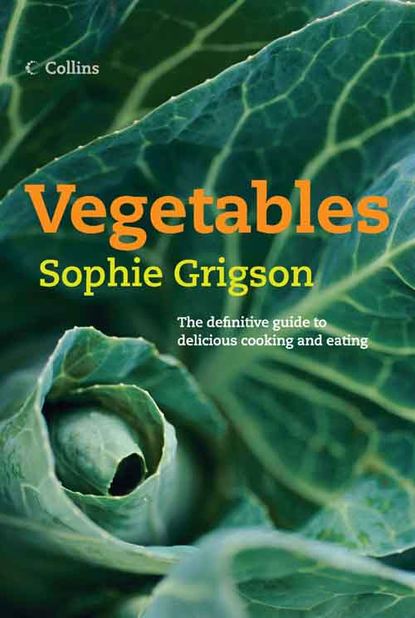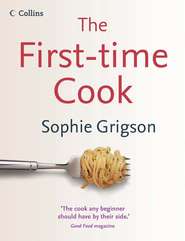По всем вопросам обращайтесь на: info@litportal.ru
(©) 2003-2024.
✖
Vegetables
Настройки чтения
Размер шрифта
Высота строк
Поля
200g (7oz) butter, softened
250g (9oz) icing sugar, sifted
1 teaspoon vanilla extract
12 walnut halves to decorate
Preheat the oven to 180°C/350°F/Gas 4. Base-line two 20cm (8in) round cake tins with baking parchment and grease the sides. Whisk the sugar with the oil, eggs and milk. Mix the flour with the baking powder, ground almonds, poppy seeds, walnuts and carrots. Make a well in the centre and add the sugary liquids, scraping the last of the sugar from the bowl. Mix the ingredients thoroughly.
Scrape into the two prepared cake tins and bake for 40–45 minutes until firm to the touch – check by plunging a skewer into the centre. If it comes out clean, then the cake is cooked. While the cake is baking, beat the cream cheese with the softened butter, icing sugar and vanilla extract to make the frosting.
Let the cakes cool in their tins for 5 minutes, then turn them out on to a wire rack. Leave to cool completely, then sandwich together with about one-third of the frosting. Spread the remaining frosting over the top and down the sides, then decorate with the walnut halves.
Celeriac (#ulink_8caec55c-c5a8-5509-9f42-31e1a0399008)
Perhaps the most brutish-looking of vegetables (swede competes for the title, and it’s hard to decide which merits the crown most), celeriac is a form of celery with an absurdly swollen rootstock, known technically as a corm. Both celeriac and celery share the Latin name Apium graveolens, even though they look so very different. When the stems are left on celeriac, sticking up like a brush, the connection is more obvious. The stems are slender, but topped with the same leaves, as if someone had squeezed hard on the broad succulent stems of a head of celery, forcing all the liquid back down into the root to puff it up like a balloon. The odd thing is that celeriac doesn’t taste at all like celery. Celeriac tastes of nothing but itself. Most people love it, and many people find it infinitely preferable to celery.
So, discount the exterior and concentrate on the firm, cream-hued interior. Solid and dense and generously proportioned, it is a remarkably delicious vegetable. I’ve never really understood why we don’t use it more: over in France it is the substance of one of their favourite mainstream salads, sold in every charcuterie and supermarket, as popular as and infinitely better than, most of the coleslaw consumed here. Yet here it is still considered something of an outsider, idly hovering on the fringes of popularity. How much longer before it breaks through to become a household name?
Oddly enough, celeriac sales were boosted by the vogue for the Atkins diet. Celeriac is, apparently, very low in carbohydrate. What a godsend for those who missed potatoes. Here was a great substitute, particularly when mashed with shedloads of cream and butter. Now that the Atkins diet is no longer as fashionable as it once was, I hope that the celeriac habit endures – it is far too engaging a vegetable to drop the minute the diet is over.
Practicalities
BUYING
Celeriac is always big, but don’t buy the most colossal ones, as these may have swelled up so far that the centre has become spongy or hollow. Be satisfied with plain big. Choose celeriac that is firm and heavy with no soft, bruised spots. Store it in the vegetable drawer of the fridge, where it will keep happily for a week or more.
COOKING
Celeriac can be cooked in a number of ways, but before that you have to take off the outer layer and the gnarled tangle of roots at the base. I usually slice the celeriac thickly then discard the roots and cut away the skin around the edge of each disc. If I’m boiling the celeriac, I then hack it into big chunks, ready to drop into the pan. If not used immediately, celeriac discolours, so once cut drop it into a bowl of water acidulated with the juice of
/
lemon or a dash of wine vinegar.
The most cherished way to serve celeriac is mashed, either à la Atkins, in other words pure celeriac and lots of rich cream and butter, or – rather nicer, both in texture and flavour – mashed with equal quantities of potato, a large knob or two of butter and some milk. Either way it begs for plenty of salt and a good scraping of nutmeg. Another fine variation that I make occasionally, especially as Christmas approaches, is a mash of celeriac and chestnuts – true, the colour is muddy, but the taste is divine. Unless you are saintly, use vacuum-packed cooked chestnuts, and mash with double the quantity of celeriac, butter and cream. Nutmeg is essential. Distract from the colour with a sprinkling of chopped chives and a knob of melting butter in the centre of the hot mash.
As with most vegetables, celeriac can be sautéed (cut into small cubes) over a lively heat, or roasted in the oven, tossed in olive oil. To make celeriac chips, parboil thick batons of celeriac (just 2–3 minutes will do the trick), drain well and then deep-fry, or shallow-fry, or toss with oil and roast in a hot oven for 10–15 minutes.
I adore a celeriac and potato dauphinoise, rich and creamy. For this one, I usually blanch the slices of celeriac and potato in boiling salted water for a couple of minutes, before layering and baking slowly in the oven until heavenly soft and tender.
Raw celeriac is rather good too. I don’t like it grated – a bit slushy – but I do like it cut into juliennes (thin batons), which increases the prep time, but is worth the bother. Remember to toss it with lemon or lime juice as you cut it, to prevent excessive browning. Although there is no reason why it shouldn’t be added to any number of salads, the classic is always going to be céleri rémoulade, for which I give a recipe overleaf. Frankly, you just can’t beat it.
SEE ALSO CELERY (PAGE 124).
Roast chicken with apple, celeriac and hazelnut stuffing
Celeriac makes a good basis for a stuffing, a strong enough flavour to come through without fighting the taste of the chicken. The celeriac ‘chips’ around the outside semi-simmer and semi-roast as the bird cooks, absorbing some of the juices from the chicken for extra flavour.
Serves 4
1 plump and happy free-range chicken a little olive oil
1/2 celeriac, peeled and cut into ‘chips’ salt and pepper
Stuffing
1/2 celeriac, peeled and finely diced
1 onion, chopped
2 cloves garlic, chopped
30g (1oz) butter
8 sage leaves, chopped
1 eating apple, cored and diced small
40g (11/2 oz) shelled, skinned hazelnuts, roasted and chopped
80g (scant 3oz) soft white breadcrumbs
1 egg, lightly beaten
Preheat the oven to 200°C/400°F/Gas 6.
To make the stuffing, begin by sautéing the celeriac, onion and garlic together in the butter until tender – take plenty of time over this, say 10 minutes or more, so that their flavours really get a chance to develop. Stir in the sage leaves and cook for a further 30 seconds or so. Now mix the vegetables and buttery juices with the apple, hazelnuts, breadcrumbs, seasoning (be generous with it) and enough beaten egg to bind.
Fill the cavity of the chicken with the stuffing. You’ll probably have more than you need, so pack the remainder into a shallow ovenproof dish and bake alongside the bird until browned and hot – it won’t taste as good as the stuffing inside the bird, but it gets the crisp crust as a bonus.
Place the stuffed bird in a roasting tin or shallow ovenproof dish and smear a little olive oil over its skin. Season generously with salt and pepper. Pour a small glass of water around the bird and surround with the celeriac chips. Roast for about 1
/
hours, basting the bird occasionally with its own juices (add a little more water if it needs it) and turning the celeriac chips occasionally – they should soften and catch a little brown here and there.
Test to make sure that the chicken is cooked by plunging a skewer into the thickest part of the thigh – if the juices run clear then it is done. If they run pink and bloody, then get the whole lot back into the oven for another 15 minutes and then try again.
Let the chicken rest in a warm place for 20 minutes before serving.
Céleri rémoulade
Whenever we’re in France we head straight for the charcuterie to buy garlic sausage and a tub of céleri rémoulade. In this instance ‘céleri’ is short for ‘céleri-rave’, in other words, celeriac. ‘Rémoulade’ indicates that it is tossed in a mustardy mayonnaise, to transform it into one of France’s favourite salad dishes. Few French domestic cooks ever make their own – why bother when the shop-bought céleri rémoulade is so good? Outside France it is another matter – especially if you make your own mayonnaise, which takes no time at all in a processor or liquidiser. The celeriac itself is best cut by hand, rather than grated, which inevitably produces an over-fine mushy salad. Soften it to agreeable floppiness by soaking in lemon juice and salt for a while.
Either serve your céleri rémoulade as one amongst a bevy of salads, or make it a first course, perhaps accompanied by some lightly cooked large prawns, or thin slices of salty Parma ham.
Serves 6







